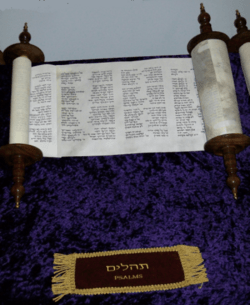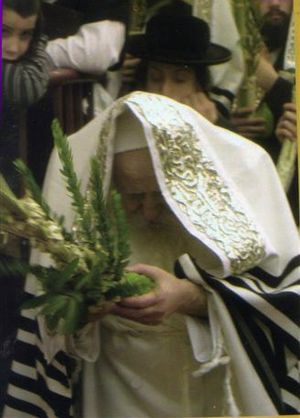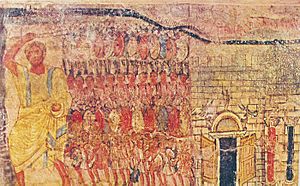Psalm 114 facts for kids
Quick facts for kids Psalm 114 |
|
|---|---|

Scroll of the Psalms.
|
|
| Book | Book of Psalms |
| Hebrew Bible part | Ketuvim |
| Order in the Hebrew part | 1 |
| Category | Sifrei Emet |
| Christian Bible part | Old Testament |
| Order in the Christian part | 19 |
Psalm 114 is the 114th psalm found in the Book of Psalms in the Bible. It is a short but powerful poem. This psalm is also known as Psalm 113 in some older versions of the Bible, like the Greek Septuagint and Latin Vulgate.
Contents
What is Psalm 114 About?
Psalm 114 has eight verses. It is like a short song with four parts, each having two lines. The psalm talks about the amazing things that happened when the people of Israel left Egypt. It describes how God led them through the Red Sea and across the Jordan River.
The psalm uses vivid pictures to show how nature reacted to God's power. It shows mountains jumping and rivers running away. This helps us understand how mighty God is. God is mentioned at the end of the psalm. This builds excitement for His great power.
This psalm starts with the Hebrew words 'בְּצֵאת יִשְׂרָאֵל, מִמִּצְרָיִם; בֵּית יַעֲקֹב, מֵעַם לֹעֵז'. It is part of a group of special prayers called the "Egyptian Hallel." Some people believe King David wrote this psalm.
The Start of the Psalm (Verses 1-2)
The first two verses of Psalm 114 say:
- 1When Israel went out of Egypt,
- The house of Jacob from a people of strange language,
- 2Judah became His sanctuary,
- And Israel His dominion.
These verses remind us that the Hebrew people became a nation when they left Egypt. The words "sanctuary" and "dominion" mean the whole Promised Land. This land was given to God's people. It was special not just geographically, but also spiritually.
The psalm uses strong images to describe the miracles. It talks about the Red Sea parting and the Jordan River stopping its flow. These images show how all of creation seemed to join with Israel. It was like nature itself helped them on their journey to the Promised Land.
How Psalm 114 is Used
Psalm 114 is important in different religious traditions.
In Judaism

- This psalm is one of six psalms (113-118) that make up the Hallel prayer.
- The Hallel is recited on many special days throughout the year.
- On these days, Psalm 114 is always said completely.
- Some Jewish traditions also recite this psalm during the Passover holiday.
In Christianity
Since the 500s, Psalm 114 has been used in Christian burial services. It is also read to people who are dying. It is also read during Easter services. This is because Israel's freedom from slavery is seen as a symbol. It represents freedom from sin.
In Orthodox Christianity
In Greek Orthodox and Slavic churches, this psalm is sung. It is part of the celebration for Theophany and Palm Sunday.
In the Catholic Church
Saint Benedict chose this psalm to be sung during evening prayers, called Vespers. This tradition started around the year 530 AD. Today, the first part of Psalm 114 is still sung or recited during Vespers on Sundays. It is often sung with a special tune called the Tonus peregrinus.
Images for kids





